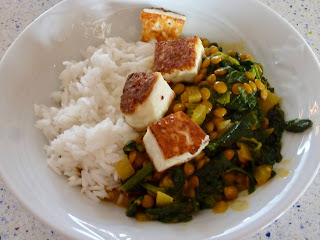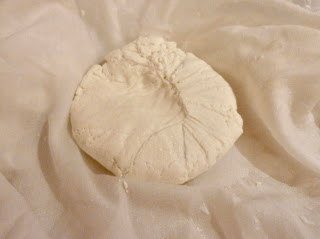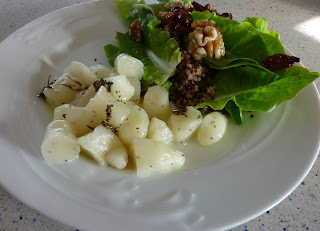I've heard of olive oil cakes, but I've never made one that I remember. The use of the oil in this case is to make the cake pareve (no meat or dairy), so it can be served with any type of meal. Because of the matzoh meal, this is not gluten-free. Kosher for Passover and Gluten Free are not synonymous, just frequently coincide. You can probably sub potato starch for that restriction, but I haven't tried it or seen any comments advocating the substitution.
The original recipe had a strawberry sauce. I chose to do blackberries because I like them better, and simply defrosted some without doing an actual sauce. That way, I got some runny juice, which you don't get from fresh fruit unless you mash it. A different day, I used some three-citrus marmalade, to enhance the lemon flavors of the cake. Any fruit works.
Having Passover by myself, I did a 1/3 recipe in a 6" springform and accepted that there would be leftovers. Scaling down the feast was a much easier task this year than last because I'd spent the year learning how much I eat.
There are three bowls involved in this recipe. I tried to simplify the directions and reduce some dishes, but it really works best this way. The portioning takes longer than the actual preparation. Once all the ingredients are measured, you can start up the oven to preheat while mixing.
6 Tb olive oil, plus more for brushing
*4 Tb matzoh meal (cake meal ok)
*2 C almond flour
1 C sugar, divided
6 eggs, room temperature, separated
*2 tsp lemon zest
*2 Tb lemon juice
1 Tb orange juice
1/2 tsp salt
1/2 C sliced almonds
1. Prepare a 10" springform pan by brushing the inside with olive oil. Line the bottom with parchment and brush the parchment with a bit more oil. Add 2 Tb matzoh meal to the springform and tap to coat, like you would flour on a cake pan. Tap out any excess. Preheat oven to 350º.
2. In a small bowl, stir together almond flour, other 2 Tb of matzoh meal, and 1/3 cup of the sugar. Get out any lumps that might have formed in the almond meal. In a large bowl, whip egg whites and salt to soft peaks. Add another 1/3 C of the sugar and beat to firm peaks.
3. In the third large bowl, beat the yolks and last 1/3 C of the sugar until light and fluffy. I had you beat the whites first so you don't have to wash the beaters in between. I tried to do it in the stand mixer, but 2 yolks weren't enough to catch the whisk. Not sure if it would work with six. Add 6 Tb olive oil, lemon zest, lemon juice, and orange juice. Beat until fluffy again and well mixed. Stir in almond flour mixture until uniform.4. In three additions, add egg whites to yolk mixture. The first, it's ok if the whites deflate. You just need to loosen the almond batter. For the last two, try to maintain a light texture. Pour into prepared pan, smooth top, and sprinkle with the almonds.
5. Bake for 40 minutes, until top is golden and set but edges are not dry. If the center of the cake jiggles when you shake it, go another 5 minutes. Allow to sit at room temperature until fully cooled. It will rather disappointingly deflate a bit, but should not collapse unless it was underbaked. Slide a knife around the edges before releasing the spring. Peel off the paper slowly, in case it folded into the cake anywhere. There's no frosting on this one, so you have to try not to crack it.6. Cake can be made ahead and left at room temperature up to 2 days. I made it earlier than that, so I froze it and defrosted on the day. After that, it lived in the fridge.7. Cake can be served as is, or with sliced fruit or a sauce made of half fresh and half puréed fruit. For a dairy meal, you could sweeten up some mascarpone cheese with a bit of sugar and serve it with a dollop topped with fruit slices.
Serves 12 -16
Difficulty rating :-0
















































